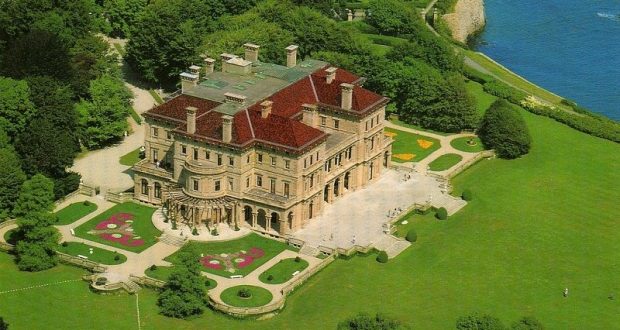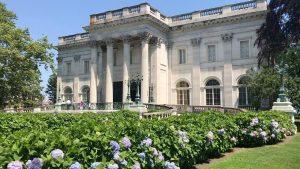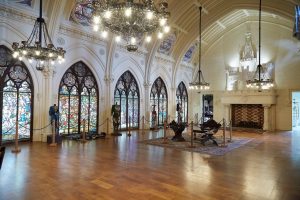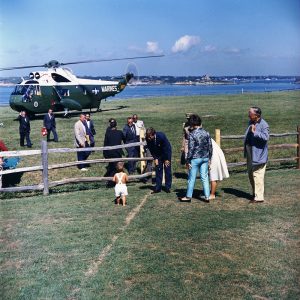FROM THE EDITOR: Sal Maccarone will be taking a brief hiatus from article writing at SNO. In his absence, he has asked us to republish some of his more popular articles from the past. This week: The Gilded Age Mansions. Enjoy!
Originally published October 11, 2020.
By Sal Maccarone
During the years following 1870 America was beginning to enjoy a bustling industrial economy. As with some of the phenomena of today’s world, a few remarkable individuals became very wealthy during this short lived era. This time period is now referred to as “The Gilded Age”, a name first coined through the title of a book which was co-authored by Mark Twain and Charles Warner. The title was meant as a satire that played upon the phrase, “Golden Age”. Because the gilding process involves the application of superficial layers of gold, Twain and Warner’s effort was in fact referring to ostentatious behavior, and materialism.
The city of Newport – in the state of Rhode Island – was somehow selected by history as the epicenter of a very pretentious display of wealth. Among many other things, Newport has always been known as an east coast resort area. This was especially true in the 1890’s when some of this country’s wealthiest families began to summer there. The social scene of the time is set forth in another book, Edith Wharton’s novel, “The Age of Innocence”, which earned her a Pulitzer Prize, (the first ever awarded to a woman). Edith maintained a home in Newport called “Land’s End”, and was herself a part of the world that she had so eloquently wrote about.
The expansive summer properties in Newport were called cottages by their Gilded Age owners because they were only enjoyed during a brief ten week period each year. But in reality, these were not in any sense of the word cottages! For instance, “The Breakers”, built by Cornelius Vanderbilt II, tallied in at an astounding sixty-five thousand square feet. The cost of this seventy-two room “cottage” at the time was more than $12,000,000, (three hundred and fifty million in today’s dollars). This elaborate get-away was designed by the famous New York architect Richard Morris Hunt (1827-1895) who also designed the pedestal for the Statue of Liberty. Mr. Hunt designed “Marble House” as well for Cornelius Vanderbilt’s brother William who gifted the 140,000 sq. ft. house to his wife Alva for her 39th birthday. Some of the outstanding features of Marble House include: a front portico that resembles the White House; 300 windows most of which look out to the sea; and of course, half a million cubic feet of Marble.
Another of the Gilded Age Newport cottages, “Belcourt Castle”, tallies in at a more modest fifty thousand square feet. Resembling a French hunting lodge, it was built by U.S. congressman, and socialite, Oliver Hazard Perry Belmont. With a sizable inheritance in hand, Oliver set out to build this French, German, English and Italian Renaissance beauty. During a time without automobiles this property was mostly famous for the opulent stable and carriage areas which were actually part of the main structure. The sixty room interior of this house was equally as impressive in that its main theme was to do with thoroughbred horses, and racing. Oliver’s father was August Belmont for which the Belmont Stakes, part of the Triple Crown, was named.
One of the most historically fascinating of the Newport properties, and my personal favorite is, “Hammersmith Farm”. This Victorian mansion complete with its own beach was built by John W. Auchincloss in 1889. Many years later it became the childhood home of Jacqueline Bouvier. This beautiful 48 acre property was also host to Jacqueline’s wedding reception in September of 1953 following her marriage to then Senator John F. Kennedy. During the Kennedy presidency, Hammersmith Farm was referred to as the summer White House.
At the end of the gilded age many of the sprawling mansions fell into complete disrepair, and were abandoned by their owners. At one point a few of them were for sale for a mere forty thousand dollars. Currently, many of the gilded age mansions continue in private use. Some have been converted for academic use. Others, such as The Breakers, have been purchased and beautifully restored by the Preservation Society of Newport County. These mansions are open for tours to the public and are a ‘must see’ for anyone visiting the east coast. Here is a link to a Newport Preservation Society introduction video to do with some of the mansions that they maintain, (https://www.youtube.com/watch?v=CR5qV6JA15E).







